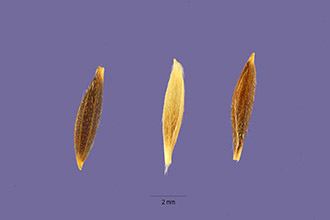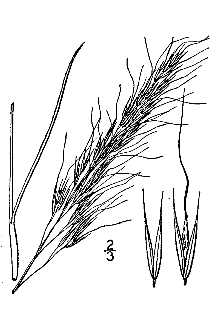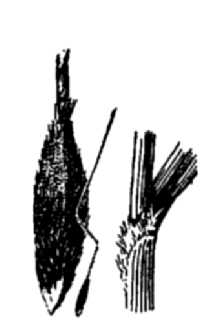Stipa viridula Trin.
Scientific Name: Stipa viridula Trin.

| General Information | |
|---|---|
| Usda Symbol | STVI4 |
| Group | Monocot |
| Life Cycle | Perennial |
| Growth Habits | Graminoid |
| Native Locations | STVI4 |
Plant Guide
Alternate Names
Feather bunchgrass, Stipa viridula
Uses
Rangeland/hayland: Green needlegrass is well suited for use in mixtures for range seeding, critical area establishment, mineland revegetation, wildlife habitat, and other plantings where the establishment of native vegetation is the objective. This species is nutritious, palatable, but decreases under grazing use. The awns are not as troublesome to livestock as with other needlegrasses. Green needlegrass is frequently included in seedings of mixed midgrasses, but due partly to its hard seed coat, it may be slow to germinate and become established.
Status
Please consult the PLANTS Web site and your State Department of Natural Resources for this plant’s current status (e, Use soil moisture sensors to measure the soil moisture of Stipa viridula Trin..,g, threatened or endangered species, state noxious status, and wetland indicator values),
Description
General: Green needlegrass is a cool-season (C3) native perennial bunchgrass. It grows to a height of 18 to 36 inches. The seed head is a compacted panicle, varying from 4 to 10 inches in length. Flowering occurs in early June with seed usually maturing in late June or early July. The awns are curved, sharply bent in the middle, and about one inch long. The leaves are often rolled, thread-like, 4 to 12 inches long, smooth, with prominent veins above. Auricles are absent. The ligule is a ring of hairs, and the sheath is hairy at the margins. This species has rather deep, fibrous roots which in favorable situations may extend to a depth of 10 feet or more. Green needlegrass is very resistant to disease. It occurs only sparingly in most associations of native vegetation. Distribution: For current distribution, please consult the Plant Profile page for this species on the PLANTS Web site. Habitat: This grass is an important native of the Northern Great Plains, and is found as far south as Arizona. Green needlegrass grows on medium to fine-textured soils in both the True Prairie and Mixed Prairie. On medium-textured soils, green needlegrass grows with western wheatgrass, needleandthread, and blue grama. On fine-textured soils, needleandthread drops out, and on even finer soils, blue grama decreases leaving green needlegrass and western wheatgrass as dominants. Green needlegrass naturally occurs on bottomlands, flat benches and overflow area along streams.
Establishment
This species is recommended for seeding mixes in the 12 to 18 inch precipitation zone. High dormancy is a characteristic of the seed of this species. Germinability improves for several years after harvest. Seedlings are slow in developing. Once established, they have good vigor. Green needlegrass has approximately 181,000 seeds per pound. The recommended seeding rate for western North and South Dakota is 6 PLS pounds per acre (25 pure live Plant Materials <http://plant-materials.nrcs.usda.gov/> Plant Fact Sheet/Guide Coordination Page <http://plant-materials.nrcs.usda.gov/intranet/pfs.html> National Plant Data Center <http://npdc.usda.gov>
Management
Hayland: Due to its early spring green-up, green needlegrass is an important component of natural plant communities. This species is harvested for hay in native grass mixtures. In some areas, it makes up an appreciable portion of the yields of native hay from upland areas or from flats, on loamy to heavy clay soils. The hay is of good quality and is readily eaten by livestock. The time of peak forage production for green needlegrass is from mid to late August. In studies carried out in North and South Dakota, the five-year average for forage production varied from 700 lb/ac on a fine sandy loam to 1,100 lb/ac on a clay loam. Crude protein is good during the early growing season. A study at Hettinger, North Dakota, indicated a range from 19 percent on April 26, to 5 percent on August 24. Pasture: Green needlegrass is not recommended for a solid seeding for grazing use. It is best used in pasture mixes. Growth begins in early spring, and cattle will seek it out. Growth continues in the fall when moisture conditions are favorable. It makes excellent recovery after grazing. It seems to stand up fairly well for winter grazing. This species will decrease under grazing use.
Seeds and Plant Production
Plant Production
Plant Production
Seed production: Seed yields from green needlegrass fields vary from about 125 lb/ac on dry land to more than 250 lb/ac for irrigated fields. Older references indicate that this species can be grown in either rows or in a solid seeding. Studies have shown that seed dormancy in this species is inversely related to maturity. This can be critical since seed in the lower panicle is still immature when that in the upper branches has ripened and started to shatter. The difference of a few days in harvest date can make a difference in amount of seed dormancy. Harvest should begin when the majority of the seed heads are black, or at the first sign of shattering. Seed harvest must be timed carefully to avoid excesses in both shattering and immaturity. Seed ripens from late June to mid-July. If seed is harvested with a seed stripper, more than one pass can be made through the field. Once harvested, the seed should be processed to remove awns. This will make the seed much more flowable through a drill. Cultivars, Improved, and Selected Materials (and area of origin) Many older references mention a variety of green needlegrass named ‘Green Stipa.’ This variety is no longer available, and was replaced by ‘Lodorm,’ which was released by the Montana, North Dakota and South Dakota Experiment Stations, along with the Plant Science Research Division of the Agricultural Research Service, Mandan, North Dakota. Lodorm originates from a bulk collection made in a native stand north of Bismarck, North Dakota, in 1935. It is a heterogeneous population of highly self-pollinated individuals. It was selected for low seed dormancy after harvest. Seed is commercially available, and the USDA, NRCS Plant Materials Center, Bismarck, North Dakota, maintains Foundation seed. ‘ACTM Mallard’ was developed as a northern hardy ecovar of green needlegrass for use in western Canada. Seed is available from Proven Seed/Agricore United. ‘Cucharas Germplasm’ was released in 2003 for use in the central Great Plains. It shows an improvement in germinability over Lodorm. Seed is available from the Utah Crop Improvement Association.
Plant Traits
Growth Requirements
| CaCO3 Tolerance | High |
|---|---|
| Frost Free Days, Minimum | 90 |
| Frost Free Days, Minimum | 90 |
| Frost Free Days, Minimum | 130 |
| Fire Tolerance | Medium |
| Fire Tolerance | Medium |
| Fire Tolerance | Medium |
| Fertility Requirement | Medium |
| Fertility Requirement | Medium |
| Fertility Requirement | Medium |
| Drought Tolerance | High |
| Drought Tolerance | High |
| Drought Tolerance | High |
| Cold Stratification Required | Yes |
| Cold Stratification Required | Yes |
| Cold Stratification Required | Yes |
| Temperature, Minimum (°F) | -38 |
| CaCO3 Tolerance | High |
| CaCO3 Tolerance | High |
| Anaerobic Tolerance | None |
| Anaerobic Tolerance | None |
| Anaerobic Tolerance | None |
| Adapted to Medium Textured Soils | Yes |
| Adapted to Medium Textured Soils | Yes |
| Adapted to Medium Textured Soils | Yes |
| Adapted to Fine Textured Soils | Yes |
| Adapted to Fine Textured Soils | Yes |
| Adapted to Fine Textured Soils | Yes |
| Adapted to Coarse Textured Soils | No |
| Adapted to Coarse Textured Soils | No |
| Adapted to Coarse Textured Soils | No |
| Hedge Tolerance | None |
| Temperature, Minimum (°F) | -38 |
| Temperature, Minimum (°F) | -33 |
| Shade Tolerance | Intolerant |
| Shade Tolerance | Intolerant |
| Shade Tolerance | Intolerant |
| Salinity Tolerance | Medium |
| Salinity Tolerance | Medium |
| Salinity Tolerance | Medium |
| Root Depth, Minimum (inches) | 14 |
| Root Depth, Minimum (inches) | 14 |
| Root Depth, Minimum (inches) | 14 |
| Precipitation, Minimum | 15 |
| Precipitation, Minimum | 15 |
| Precipitation, Minimum | 15 |
| Precipitation, Maximum | 24 |
| Hedge Tolerance | None |
| Hedge Tolerance | None |
| Moisture Use | Low |
| Moisture Use | Low |
| Moisture Use | Low |
| pH, Maximum | 8.4 |
| pH, Maximum | 8.4 |
| pH, Maximum | 8.4 |
| pH, Minimum | 6.6 |
| pH, Minimum | 6.6 |
| pH, Minimum | 6.6 |
| Precipitation, Maximum | 24 |
| Precipitation, Maximum | 24 |
Morphology/Physiology
| Active Growth Period | Spring and Summer |
|---|---|
| Toxicity | None |
| Toxicity | None |
| Toxicity | None |
| Shape and Orientation | Erect |
| Shape and Orientation | Erect |
| Shape and Orientation | Erect |
| Resprout Ability | No |
| Resprout Ability | No |
| Flower Conspicuous | No |
| Fall Conspicuous | No |
| Fire Resistant | No |
| Fire Resistant | No |
| Fire Resistant | No |
| Flower Color | Yellow |
| Flower Color | Yellow |
| Flower Color | Yellow |
| Flower Conspicuous | No |
| Fall Conspicuous | No |
| Flower Conspicuous | No |
| Foliage Color | Green |
| Foliage Color | Green |
| Foliage Color | Green |
| Foliage Porosity Summer | Dense |
| Foliage Porosity Summer | Dense |
| Foliage Porosity Summer | Dense |
| Foliage Porosity Winter | Porous |
| Bloat | None |
| Resprout Ability | No |
| Active Growth Period | Spring and Summer |
| Active Growth Period | Spring and Summer |
| After Harvest Regrowth Rate | Rapid |
| After Harvest Regrowth Rate | Rapid |
| After Harvest Regrowth Rate | Slow |
| Bloat | None |
| Bloat | None |
| Nitrogen Fixation | None |
| C:N Ratio | Medium |
| C:N Ratio | Medium |
| C:N Ratio | Medium |
| Coppice Potential | No |
| Coppice Potential | No |
| Coppice Potential | No |
| Fall Conspicuous | No |
| Lifespan | Moderate |
| Height, Mature (feet) | 2.0 |
| Height, Mature (feet) | 2.5 |
| Known Allelopath | No |
| Known Allelopath | No |
| Known Allelopath | No |
| Leaf Retention | No |
| Leaf Retention | No |
| Leaf Retention | No |
| Foliage Porosity Winter | Porous |
| Lifespan | Moderate |
| Lifespan | Moderate |
| Low Growing Grass | No |
| Low Growing Grass | No |
| Low Growing Grass | No |
| Nitrogen Fixation | None |
| Nitrogen Fixation | None |
| Growth Rate | Rapid |
| Height, Mature (feet) | 2.0 |
| Foliage Porosity Winter | Porous |
| Foliage Texture | Medium |
| Foliage Texture | Medium |
| Foliage Texture | Medium |
| Fruit/Seed Color | Brown |
| Fruit/Seed Color | Brown |
| Fruit/Seed Color | Brown |
| Fruit/Seed Conspicuous | No |
| Fruit/Seed Conspicuous | No |
| Growth Form | Bunch |
| Growth Form | Bunch |
| Growth Form | Bunch |
| Growth Rate | Rapid |
| Growth Rate | Rapid |
| Fruit/Seed Conspicuous | No |
Reproduction
| Fruit/Seed Persistence | No |
|---|---|
| Propagated by Tubers | No |
| Propagated by Tubers | No |
| Propagated by Tubers | No |
| Propagated by Sprigs | No |
| Propagated by Sprigs | No |
| Propagated by Sprigs | No |
| Propagated by Sod | No |
| Propagated by Sod | No |
| Propagated by Sod | No |
| Propagated by Seed | Yes |
| Propagated by Seed | Yes |
| Propagated by Seed | Yes |
| Propagated by Cuttings | No |
| Propagated by Cuttings | No |
| Seed per Pound | 167840 |
| Seed per Pound | 167840 |
| Seed per Pound | 167840 |
| Seed Spread Rate | Slow |
| Seed Spread Rate | Slow |
| Seed Spread Rate | Slow |
| Seedling Vigor | High |
| Seedling Vigor | High |
| Seedling Vigor | High |
| Small Grain | No |
| Small Grain | No |
| Small Grain | No |
| Vegetative Spread Rate | None |
| Vegetative Spread Rate | None |
| Vegetative Spread Rate | None |
| Propagated by Corm | No |
| Propagated by Cuttings | No |
| Bloom Period | Late Spring |
| Bloom Period | Late Spring |
| Bloom Period | Late Spring |
| Commercial Availability | Routinely Available |
| Commercial Availability | Routinely Available |
| Commercial Availability | Routinely Available |
| Fruit/Seed Abundance | High |
| Fruit/Seed Abundance | Medium |
| Fruit/Seed Abundance | Medium |
| Fruit/Seed Period Begin | Summer |
| Fruit/Seed Period Begin | Summer |
| Fruit/Seed Period Begin | Summer |
| Fruit/Seed Period End | Summer |
| Fruit/Seed Period End | Summer |
| Fruit/Seed Persistence | No |
| Fruit/Seed Period End | Summer |
| Propagated by Corm | No |
| Propagated by Corm | No |
| Propagated by Container | No |
| Propagated by Container | No |
| Propagated by Container | No |
| Propagated by Bulb | No |
| Propagated by Bulb | No |
| Propagated by Bulb | No |
| Propagated by Bare Root | No |
| Propagated by Bare Root | No |
| Propagated by Bare Root | No |
| Fruit/Seed Persistence | No |
Suitability/Use
| Palatable Browse Animal | Medium |
|---|---|
| Palatable Graze Animal | Medium |
| Palatable Graze Animal | Medium |
| Palatable Graze Animal | Medium |
| Palatable Human | No |
| Palatable Human | No |
| Palatable Human | No |
| Post Product | No |
| Post Product | No |
| Post Product | No |
| Protein Potential | Medium |
| Protein Potential | Medium |
| Protein Potential | Medium |
| Pulpwood Product | No |
| Pulpwood Product | No |
| Pulpwood Product | No |
| Veneer Product | No |
| Veneer Product | No |
| Veneer Product | No |
| Lumber Product | No |
| Berry/Nut/Seed Product | No |
| Berry/Nut/Seed Product | No |
| Berry/Nut/Seed Product | No |
| Christmas Tree Product | No |
| Christmas Tree Product | No |
| Christmas Tree Product | No |
| Fodder Product | Yes |
| Fodder Product | Yes |
| Fodder Product | Yes |
| Palatable Browse Animal | Medium |
| Lumber Product | No |
| Lumber Product | No |
| Naval Store Product | No |
| Naval Store Product | No |
| Naval Store Product | No |
| Nursery Stock Product | No |
| Nursery Stock Product | No |
| Nursery Stock Product | No |
| Palatable Browse Animal | Medium |


